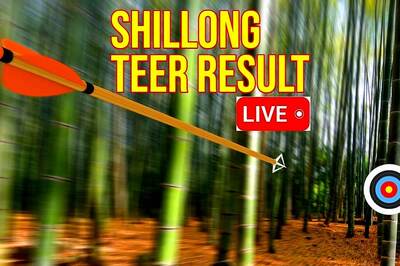
views
Red and Blue LED Light Therapy Benefits
Red light therapy can improve the appearance of signs of aging. One study found a decrease in the severity of wrinkles after participants received LED light therapy twice weekly for four weeks. Other studies showed subtle or more noticeable improvement in redness, dark spots, and loose or rough-feeling skin. LED light therapy can promote the production of collagen, helping to firm and tighten skin. One study suggested photobiomodulation or red LED light therapy could reverse the visible signs of aging for up to one month after three months of biweekly treatments. Red-light therapy has also been used to regrow hair after hereditary hair loss, although research on this usage is limited.
Blue light therapy can treat acne. One study found that blue light therapy helped reduce inflammatory lesions in patients with mild-to-moderate acne after five weeks of bi-weekly treatment. Blue light therapy is FDA-approved for the treatment of moderate acne vulgaris.
Infrared and red LED light therapy can treat psoriasis and wounds. One study saw psoriatic plaque clearance rates from 60 to 100 percent after 4 to 5 weeks of biweekly treatment with LED light therapy at different wavelengths. Another study saw beneficial effects of red LED light therapy on speeding up the healing of wounds. Red light therapy has also been promoted as a treatment for rosacea and eczema.
Red and Blue LED Light Therapy Risks
There are no known risks to red and blue light therapy. When you properly use at-home LED light therapy products—or receive LED light therapy treatments from a licensed professional—the treatment is considered safe. More research is needed to understand the long-term effects of LED light therapy. LED light therapy doesn’t use cancer-causing UV light. To avoid improper treatment, only receive professional red and blue light therapy treatment from a licensed dermatologist or esthetician.
Blue light therapy may cause minor side effects. Some studies on using blue light LED therapy to treat acne found that participants experienced swelling and dryness after treatment. Others had temporary changes in the pigment of their skin. Another study found that participants’ cystic acne lesions worsened after a blue light therapy treatment, suggesting it may not help all types of acne. Some people may experience slight pain or irritation after LED light therapy. If this persists, consult your dermatologist and discontinue use of any at-home devices.
Avoid LED light therapy if you have certain conditions or use certain medications. If you have diabetes, a history of skin cancer, lupus, or another condition that makes your eyes and skin sensitive to light damage, avoid light therapy. Similarly, if you’re on a medication or antibiotic like lithium, melatonin, or isotretinoin that is photosensitizing, you may not be a good candidate for light therapy. Consult your dermatologist or physician if you’re unsure.
How to Do Red and Blue Light Therapy at Home
Take precautions to avoid potential damage from LED light therapy. Wear protective goggles before treatment to prevent damage to your eyes. Only use FDA-cleared at-home red and blue light therapy products. Consult a dermatologist to ensure that LED light therapy is a safe and effective treatment for your particular needs. Use at-home products for the recommended amount of time. Using them for too long could potentially damage your skin. FDA approved or cleared devices aren’t guaranteed to be effective. The label just means the FDA has decided they don’t post a safety risk and are safe for public use. However, clinical research points to the effectiveness of LED light therapy.
Find the right device for your needs and budget. The most common LED light therapy tool for at-home use is a mask, though you can also use a wand, lamp, or hand-held spot-treating device. LED light therapy devices may specify that they’re intended for acne treatment, anti-aging, or hair regeneration. Look for this information on the product page or packaging before purchasing to make sure it meets your needs. Devices range in price. Consider purchasing a cheaper mask and tracking your personal results before splurging on an expensive product. Look for an FDA-cleared label on the packaging to ensure the device is safe to use. Some devices only emit red or blue light, while others can emit both. Which one you purchase depends on your treatment goals. For example, you may not need blue LED light therapy if you do not suffer from acne.
Read and follow all device instructions for use. Most red and blue light therapy devices require 10 to 20 minutes of treatment per at-home session. Treatment is typically applied two times a week, with three to four days between treatments. To see results, you’ll generally need to do repeat treatments for anywhere from four to twelve weeks. Cosmetologist Heidi Mesbah notes that many devices can touch the skin, but professional lights (1200 to 1500 LED light devices) may need to be five inches away. Mesbah says 20 minutes is usually the maximum treatment time. “You can do more than that, but you’re not really doing anything good to yourself because it’s just too much.” To see if light therapy is working for you, take pictures before and after each treatment. If you don’t see your desired results over time, consider receiving in-office LED light therapy. Professionals have stronger devices that may deliver faster, more effective results.
Use sunscreen and avoid sun exposure after treatment. Red and blue light therapy treatments may increase your skin’s sensitivity to sunlight. To avoid damage, apply sunscreen when you’re in the sun after treatment. Use a parasol for extra protection. In general, try to limit your time in direct sunlight in the days following treatment.
How long does it take to see results?
Expect noticeable results after six to 12 treatments. According to Mesbah, while you should see a subtle difference right after receiving red light therapy, it takes more treatments for dramatic results. She says to do six to 12 sessions, either once or twice a week, for cumulative results.
How does LED light therapy work?
Red light therapy triggers changes in your cells. When you use a mask or wand for LED light therapy, the LEDs (light emitting diodes) emit red light energy at a wavelength around 630 nm. The red light’s energy is absorbed by your cells. This absorption causes cellular-level changes that help treat various skin problems, such as visible signs of aging and conditions like psoriasis. Specifically, red light therapy may stimulate the production of collagen, reduce inflammation, and increase blood circulation.
Blue light therapy kills acne-causing bacteria. Acne-causing bacteria release substances called porphyrins. When you do a blue LED light treatment, the wavelengths of light are absorbed by the porphyrins. This produces free radical damage that kills the bacteria. LED light therapy may also reduce inflammation, minimizing the appearance of acne. Free radical damage to the skin has been theorized to contribute to aging over time, although this theory has been questioned by the scientific community recently.
Can you do red and blue LED light therapy together?
You can do red and blue light therapy at the same time. Some at-home LED light therapy devices have settings that turn on red and blue LEDs at the same time. However, such a setting would mean only some areas of your face were receiving each kind of therapy. It’s more common in clinical studies and in practice to do red light therapy and blue light therapy in alternating cycles. There’s limited research on the effects of doing both kinds of LED light therapy together.



















Comments
0 comment